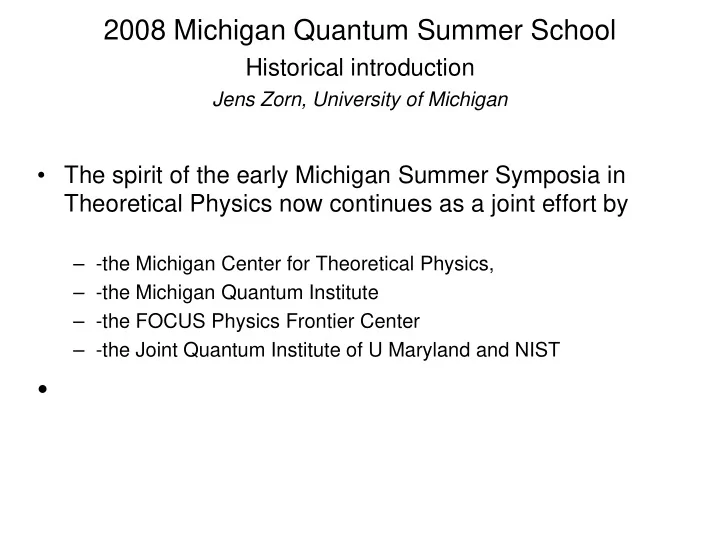

2008 Michigan Quantum Summer School Historical introduction Jens Zorn, University of Michigan • The spirit of the early Michigan Summer Symposia in Theoretical Physics now continues as a joint effort by – -the Michigan Center for Theoretical Physics, – -the Michigan Quantum Institute – -the FOCUS Physics Frontier Center – -the Joint Quantum Institute of U Maryland and NIST •
Michigan Summer Symposia • In the early 1920’s UM had strong experimental programs with a dozen faculty in nuclear physics, x-rays, atomic & molecular (particularly infrared) spectroscopy. • However, Walter Colby was the only theorist conversant with modern problems Remedies taken: 1923 Oskar Klein comes. 1923-27 Summer lecture program runs • Speakers include KT Compton, FA Saunders, Karl Herzfeld, W. L. Bragg, E A Milne, Harvey Fletcher. … This program is well received, • but • Subcritical mass of theorists led Klein to return to Europe 1925.
Michigan response to loss of Klein Recruit four young, highly-accomplished theorists: in 1926 Laporte (dipole selection rule), in 1927 Goudsmit, Uhlenbeck (electron spin), and also in 1927 Dennison (proton spin). Start the Michigan Summer Symposia: In 1928 Michigan began an ambitious summer program to give ambitious physicists from the entire country an extended opportunity to engage the best minds of the day. These Symposia ran at full strength from 1928 to 1941. Typical attendance on the order of 100 physicists, (60% graduate students and 40% posdoctoral scholars).
Sample of visiting lecturers (extended stays) with frequency of their appearance, 1928-1941 Bethe xx London x Bloch x Pauli xx Breit xxx Rabi x Brioullin x Schwinger x Condon xx Seitz xx Dirac x Sommerfeld x Ehrenfest x VanVleck x Fermi xxxxx Wheeler x Heisenberg x Wigner x Kramers xx Weisskopf x Lawrence xx
1931 courses Sommerfeld Electron Theory of Metals (4 weeks) Sommerfeld Problems of Wave Mechanics (4 weeks) Pauli Nuclear Physics (4 weeks) Pauli Quantum Theory of Equilibrium (4 weeks) Kramers Quantum Mechanics and Classical Models Oppenheimer Quantum Theory of Transitions Uhlenbeck Probability in Physics Laporte Theory of Atomic Spectra
1933 courses Bohr Foundations of quantum mechanics Fermi Structure of the atomic nucleus Van Vleck Atomic Magnetism Goudsmit Atomic Spectra Uhlenbeck Quantum Mechanics Dennison Molecular Band Spectra
1941 courses Pauli Recent Field Theories Seitz Theory of Solids (five weeks) Schwinger Nuclear Forces (four weeks) Weisskopf Nuclear Reactions (two weeks)
Circumstances for Symposium success 1928-1941 • Exciting physics with solid basis for theoretical analysis • The migration of refugee scientists from Europe • Strength of personal relationships in pre-WWII physics community • Ann Arbor locale (tradition, climate, …) • also • Economics : not much summer research funding. • Modest expectations of symposium attendees.(lodgingi, etc) • Absence of competing conferences.
Symposia after 1946 • The Michigan Symposia did continue for several years after WWII, but it was difficult to maintain the earlier spirit and method. (exception: 1950 symposium on quantum electrodynamics when Schwinger lectured, Dyson explained.) • Physics was in a rapid period of growth and the needs of the physics community had changed. There were many demands on the time of its practioners. Competing conferences were started. • After 1950 the Michigan money available for symposium support tended to be used for smaller and shorter gatherings that focused on more specialized problems [nuclear structure, optical pumping, non-linear phenomena..]
The recent past • Over the past decade, MCTP, FOCUS, and other intra-campus and intercampus research groups have organized conferences, workshops, and more extended gatherings to further the progress of research in physics and related disciplines. . • This 2008 Michigan Quantum Summer School is perhaps the most ambitious of these efforts.
12 • We open the Michigan Quantum Summer School so that you enjoy the opportunities to learn new material and to explore creative ideas in an atmosphere that is both collegiate and collegial. • Welcome to Ann Arbor
Recommend
More recommend